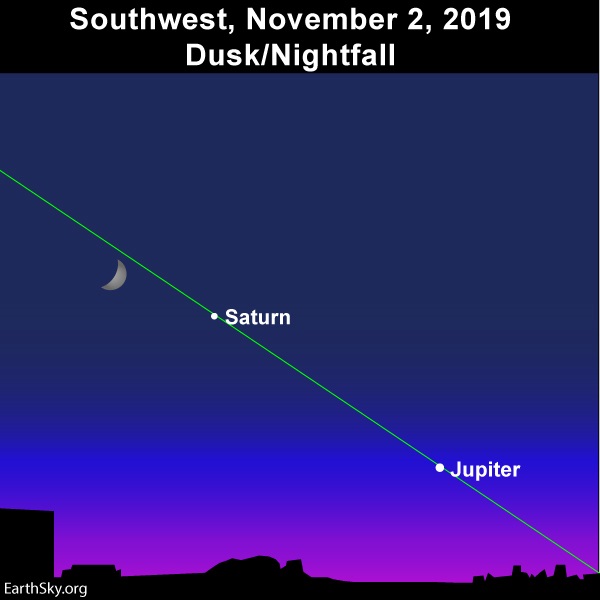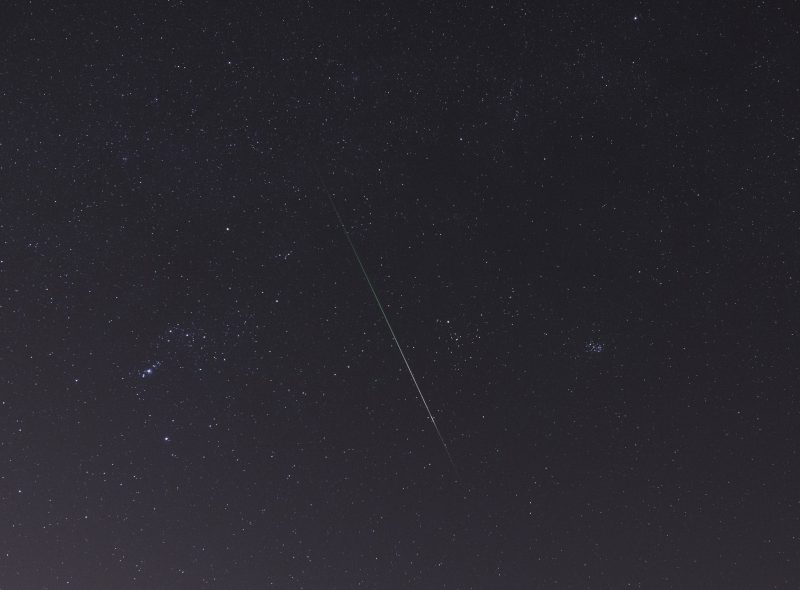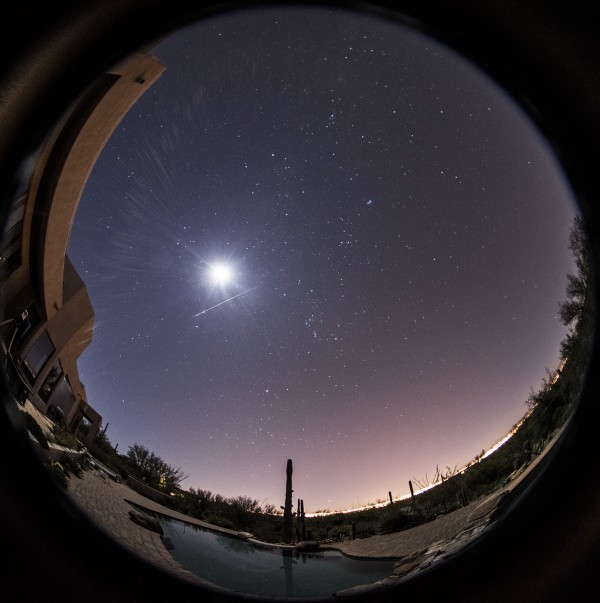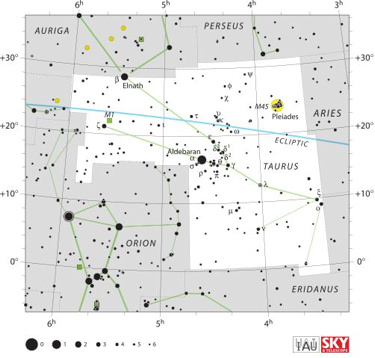
We haven’t heard from many people who’ve seen fireballs in either of the long-lasting South or North Taurid meteor showers this year. Still, it’s always worth keeping an eye out. Various sources give wildly different dates for the peak date of South Taurids (active from late September to late November). November 6, 2019, is one of those predicted dates. November 4 and 5, 2019, might be good nights to watch for meteors, too, possibly featuring a higher-than-average rate of South Taurid meteors. There is less moonlight tonight and tomorrow night – November 2 and 3, 2019 – so don’t discount these nights, either.
Click here for the moonset times in your sky, remembering to check the moonrise and moonset box.
Skywatchers are still remembering the Taurid fireballs they saw in 2015. The Taurids appear to have a 7-year cycle of bright fireballs, and 2015 was apparently a peak year! Read more about that, and see more fireball photos, here.
2019? Not so much. But you never know.

The moon sets at early evening on November 2, 2019, leaving dark skies for meteor watching. Will you see any? We can’t know. But we do know you won’t, if you don’t watch.
Both the South and North Taurids (which is active from late October to early December, and peaks somewhere around November 12) are long, spread-out showers with no well-defined peak. During the peak nights for the South Taurid meteor shower, you might see as many as five meteors per hour. But The American Meteor Society explains what – in some years – can be awesome about the Taurid meteor showers:
The Taurids (both branches) are rich in fireballs and are often responsible for increased number of fireball reports from September through November.
Fireballs are the name of the game for the Taurids.
Seeing a Taurid fireball – even if it’s just one – counts as a big thrill. And, by the way, a fireball is just another word for a particularly bright meteor.

Eliot Herman in Tuscon, Arizona, caught this bright Taurid on October 28, 2016. Go to his Flickr page if you want to see it larger. Nice colors!
On any given night, these rather slow-moving meteors produce the greatest numbers in the few hours after midnight. At that time, the moon will have set or will be close to setting. Because the waxing (increasing) moon will set an hour later with each passing night, you’ll have more moon-free viewing on November 2 and 3 than the two following nights (November 4 and 5).
So we’re guaranteed to have deliciously dark skies for the South Taurids in the wee hours after midnight tonight, to highlight any Taurid fireball that might come whizzing by.
Click here to find out when the moon sets in your sky, remembering to check the moonrise and moonset box.

You can see this meteor is radiating from the constellation Taurus the Bull. See that V-shaped pattern to the right of Orion? The three Belt stars of Orion point to it. That’s the Bull’s Face. Eliot Herman in Tucson caught this Taurid meteor, too, in 2015. The bright object was the moon! Thanks, Eliot.
The other Taurid shower – the North Taurids – should add a few more meteors to the mix from late night until dawn.
And again … the Taurid showers do not exhibit strong peaks. So if you’re clouded out tonight and tomorrow, no problem. Just keep watching. The two Taurid showers tend to overlap and to plateau in activity during the first few weeks in November.
If you trace the South Taurid meteors backwards, they all appear to radiate from the constellation Taurus the Bull. As always, you don’t have to identify a meteor shower’s radiant point to watch the meteor shower. Just lie back comfortably and look up, in the hours between midnight and dawn.
By the way, the constellation Taurus itself is full of interesting things to see such as the Pleiades star cluster, the V-shaped Hyades cluster with bright Aldebaran in its midst.
Just be aware … you don’t need to find Taurus to watch the Taurid shower, for these meteors streak all over the sky.

Bottom line: The annual South Taurid meteor shower has been going on throughout October, and now the North Taurids have started as well. The peaks of these showers aren’t well defined, but the South Taurids might be peaking in the first week of November, 2019. Watch for them.
Enjoying EarthSky so far? Sign up for our free daily newsletter today!
EarthSky’s meteor shower guide for 2019
See it! Best photos of 2015 Taurid fireballs
from EarthSky https://ift.tt/2OmUq7U

We haven’t heard from many people who’ve seen fireballs in either of the long-lasting South or North Taurid meteor showers this year. Still, it’s always worth keeping an eye out. Various sources give wildly different dates for the peak date of South Taurids (active from late September to late November). November 6, 2019, is one of those predicted dates. November 4 and 5, 2019, might be good nights to watch for meteors, too, possibly featuring a higher-than-average rate of South Taurid meteors. There is less moonlight tonight and tomorrow night – November 2 and 3, 2019 – so don’t discount these nights, either.
Click here for the moonset times in your sky, remembering to check the moonrise and moonset box.
Skywatchers are still remembering the Taurid fireballs they saw in 2015. The Taurids appear to have a 7-year cycle of bright fireballs, and 2015 was apparently a peak year! Read more about that, and see more fireball photos, here.
2019? Not so much. But you never know.

The moon sets at early evening on November 2, 2019, leaving dark skies for meteor watching. Will you see any? We can’t know. But we do know you won’t, if you don’t watch.
Both the South and North Taurids (which is active from late October to early December, and peaks somewhere around November 12) are long, spread-out showers with no well-defined peak. During the peak nights for the South Taurid meteor shower, you might see as many as five meteors per hour. But The American Meteor Society explains what – in some years – can be awesome about the Taurid meteor showers:
The Taurids (both branches) are rich in fireballs and are often responsible for increased number of fireball reports from September through November.
Fireballs are the name of the game for the Taurids.
Seeing a Taurid fireball – even if it’s just one – counts as a big thrill. And, by the way, a fireball is just another word for a particularly bright meteor.

Eliot Herman in Tuscon, Arizona, caught this bright Taurid on October 28, 2016. Go to his Flickr page if you want to see it larger. Nice colors!
On any given night, these rather slow-moving meteors produce the greatest numbers in the few hours after midnight. At that time, the moon will have set or will be close to setting. Because the waxing (increasing) moon will set an hour later with each passing night, you’ll have more moon-free viewing on November 2 and 3 than the two following nights (November 4 and 5).
So we’re guaranteed to have deliciously dark skies for the South Taurids in the wee hours after midnight tonight, to highlight any Taurid fireball that might come whizzing by.
Click here to find out when the moon sets in your sky, remembering to check the moonrise and moonset box.

You can see this meteor is radiating from the constellation Taurus the Bull. See that V-shaped pattern to the right of Orion? The three Belt stars of Orion point to it. That’s the Bull’s Face. Eliot Herman in Tucson caught this Taurid meteor, too, in 2015. The bright object was the moon! Thanks, Eliot.
The other Taurid shower – the North Taurids – should add a few more meteors to the mix from late night until dawn.
And again … the Taurid showers do not exhibit strong peaks. So if you’re clouded out tonight and tomorrow, no problem. Just keep watching. The two Taurid showers tend to overlap and to plateau in activity during the first few weeks in November.
If you trace the South Taurid meteors backwards, they all appear to radiate from the constellation Taurus the Bull. As always, you don’t have to identify a meteor shower’s radiant point to watch the meteor shower. Just lie back comfortably and look up, in the hours between midnight and dawn.
By the way, the constellation Taurus itself is full of interesting things to see such as the Pleiades star cluster, the V-shaped Hyades cluster with bright Aldebaran in its midst.
Just be aware … you don’t need to find Taurus to watch the Taurid shower, for these meteors streak all over the sky.

Bottom line: The annual South Taurid meteor shower has been going on throughout October, and now the North Taurids have started as well. The peaks of these showers aren’t well defined, but the South Taurids might be peaking in the first week of November, 2019. Watch for them.
Enjoying EarthSky so far? Sign up for our free daily newsletter today!
EarthSky’s meteor shower guide for 2019
See it! Best photos of 2015 Taurid fireballs
from EarthSky https://ift.tt/2OmUq7U

Aucun commentaire:
Enregistrer un commentaire